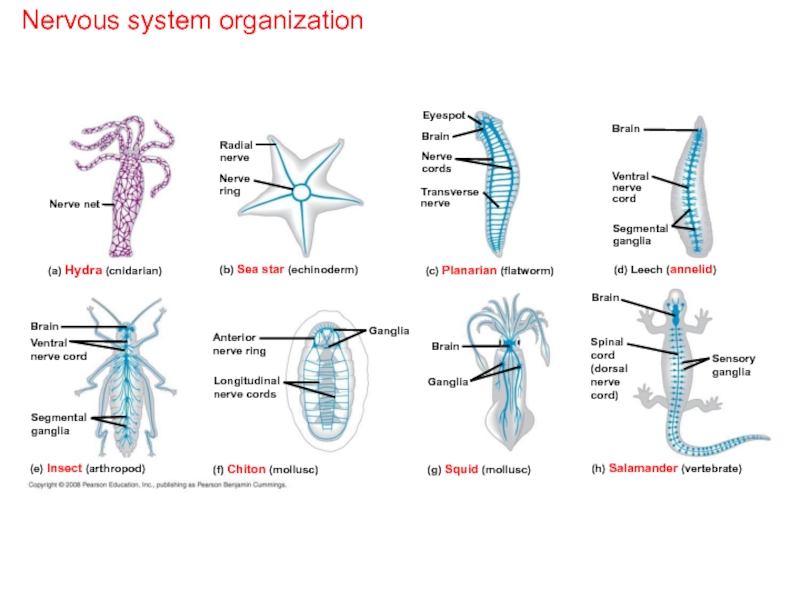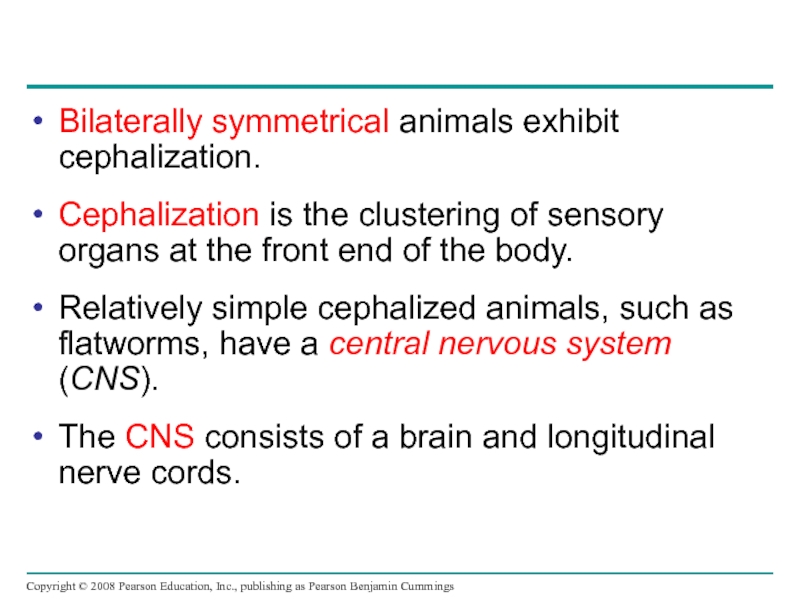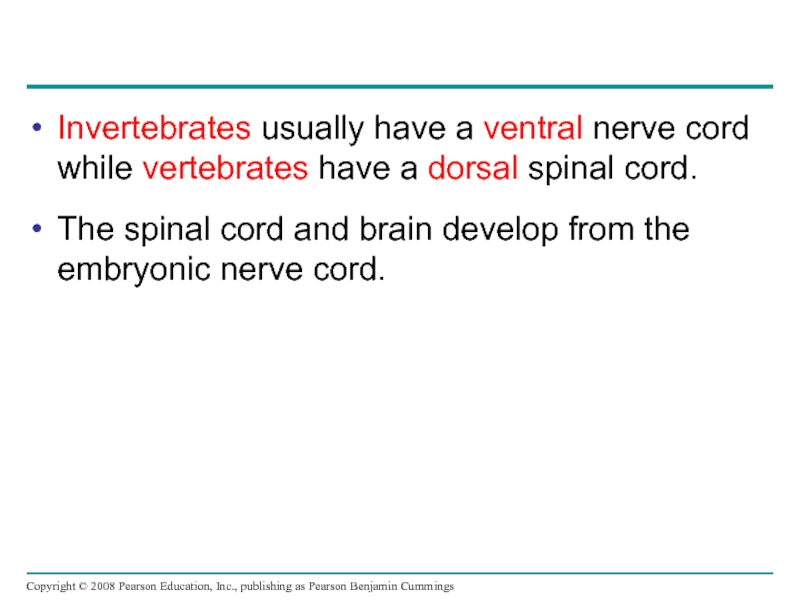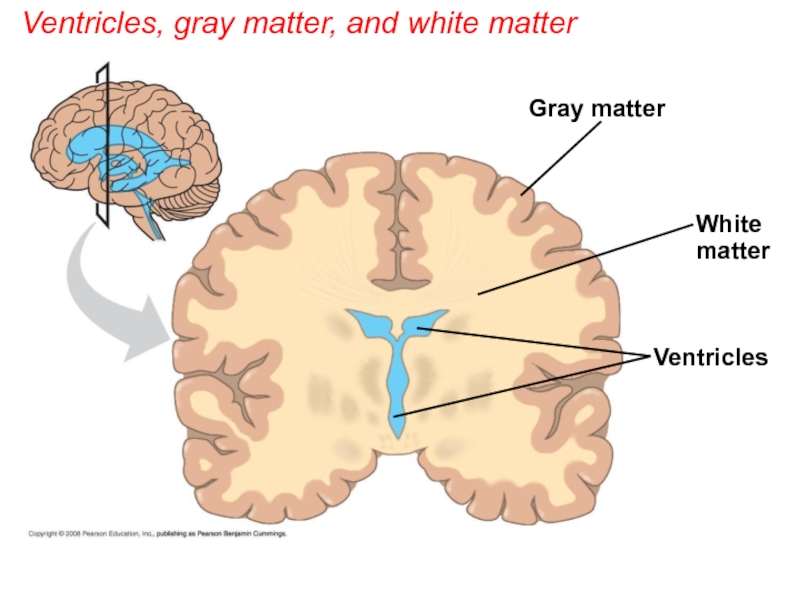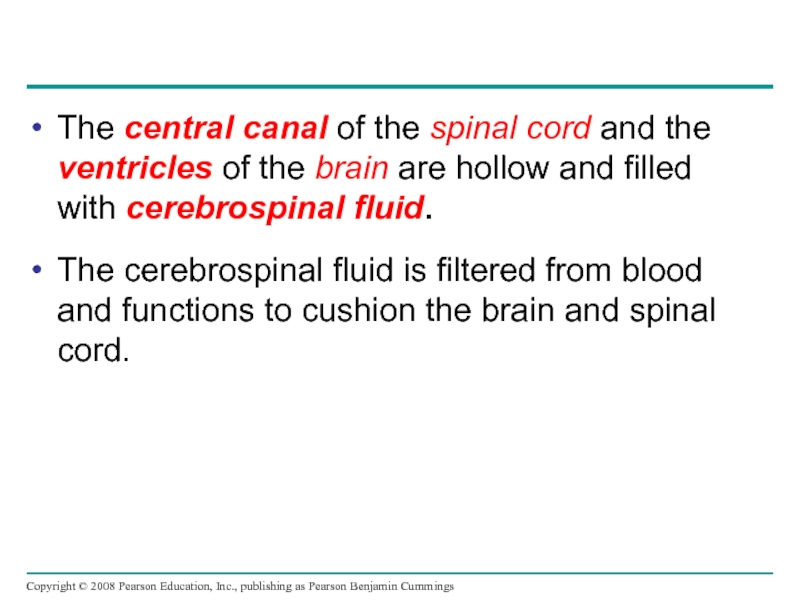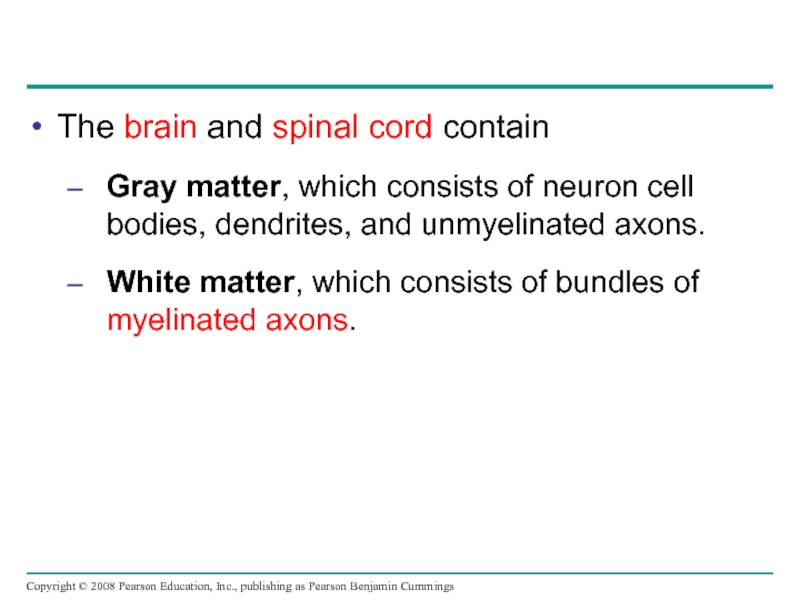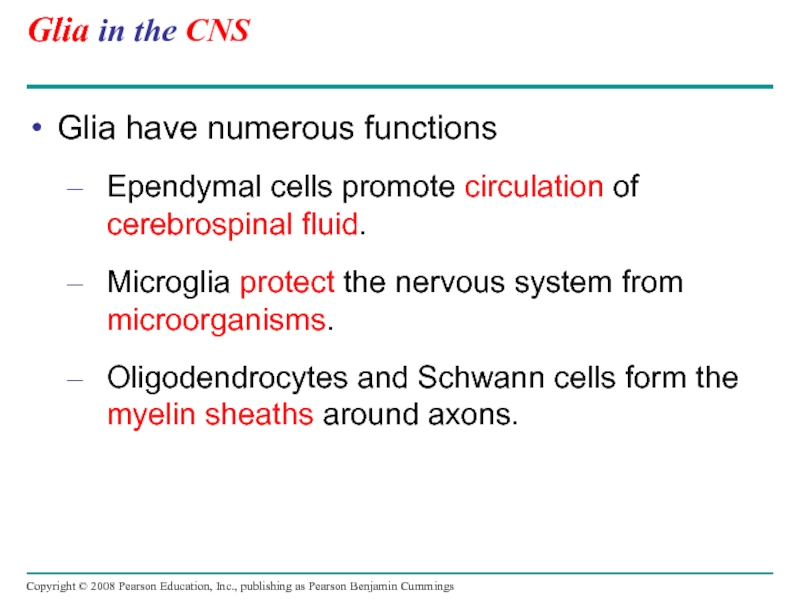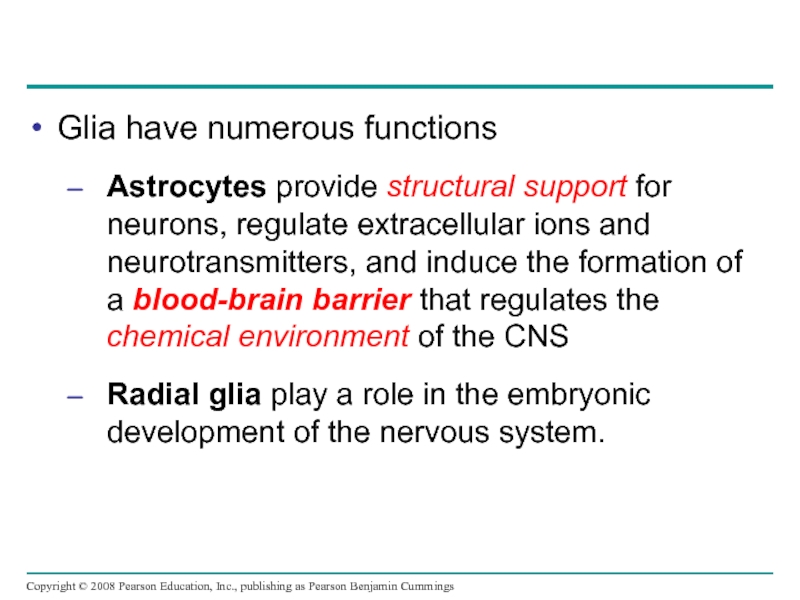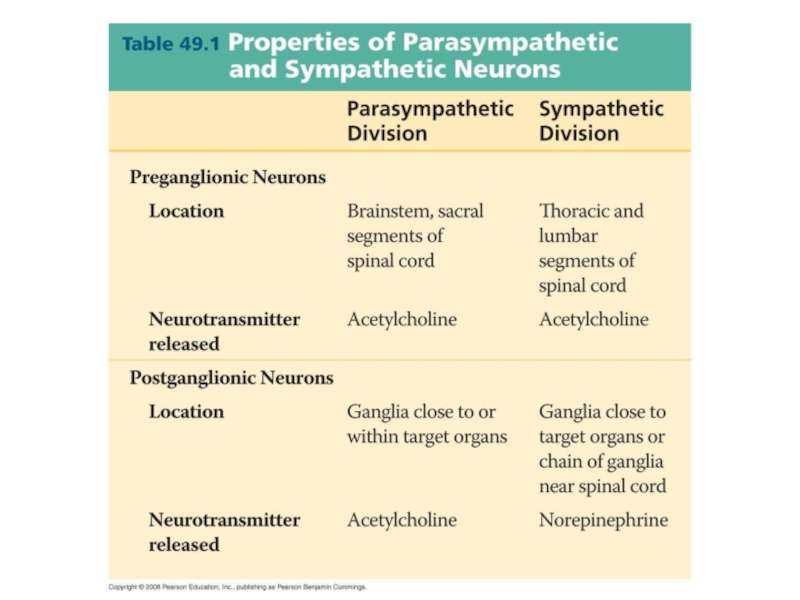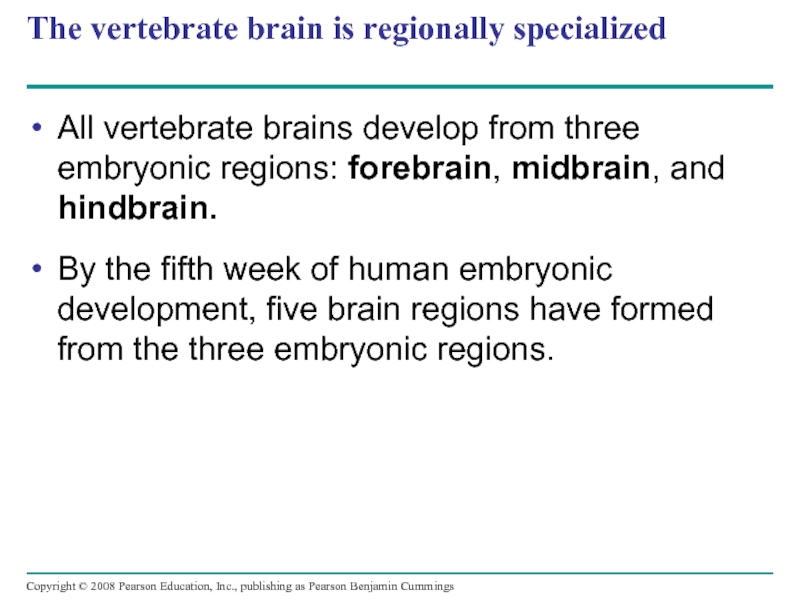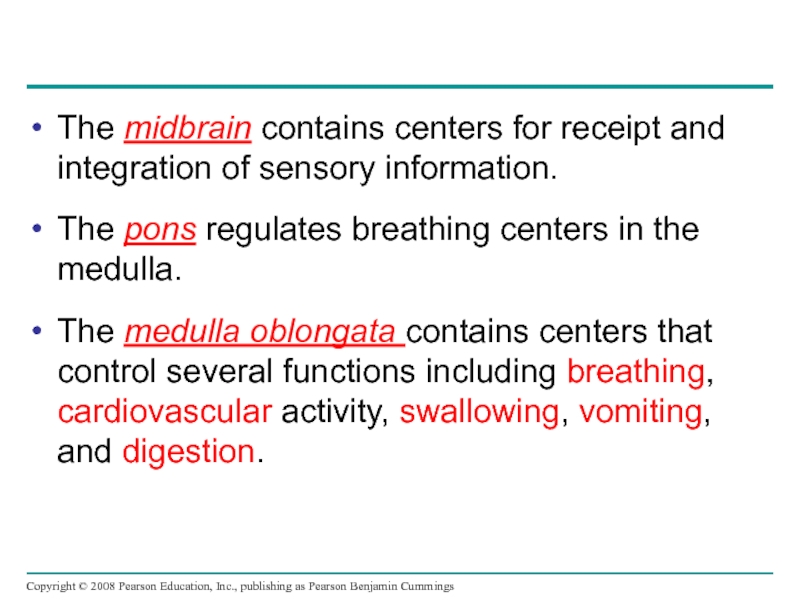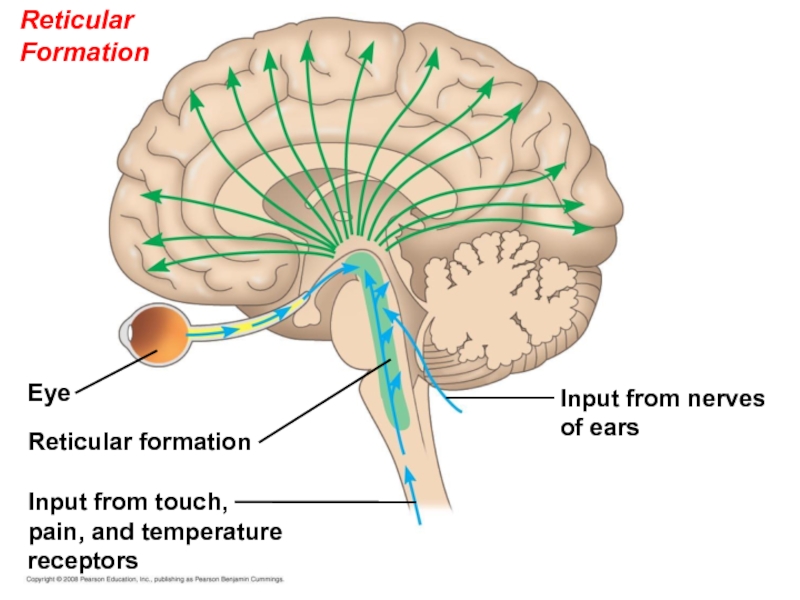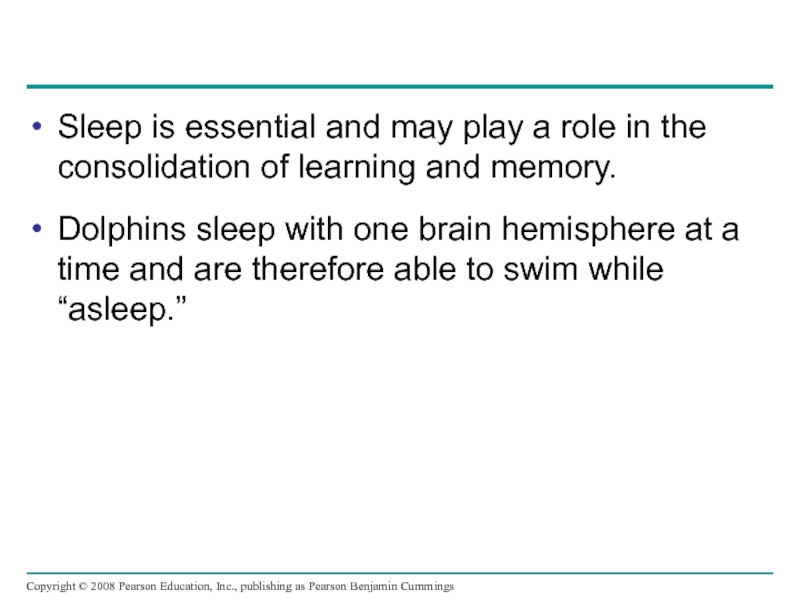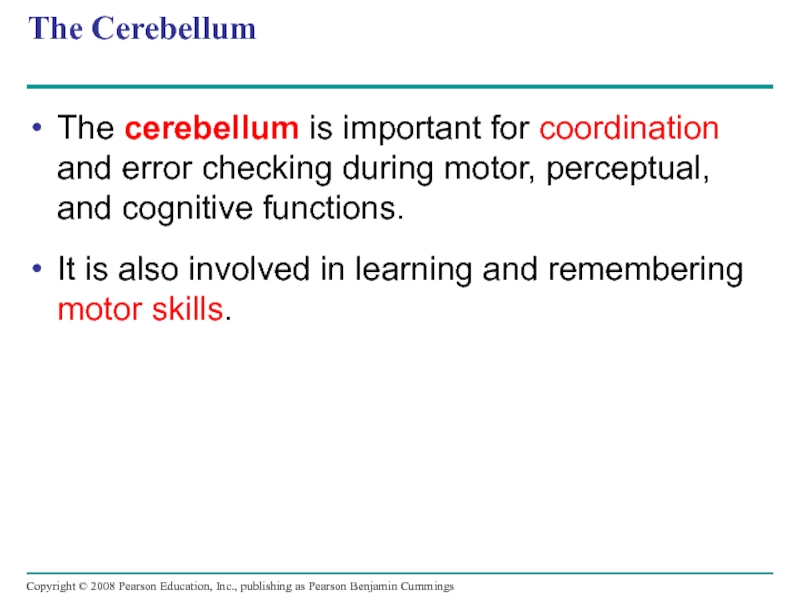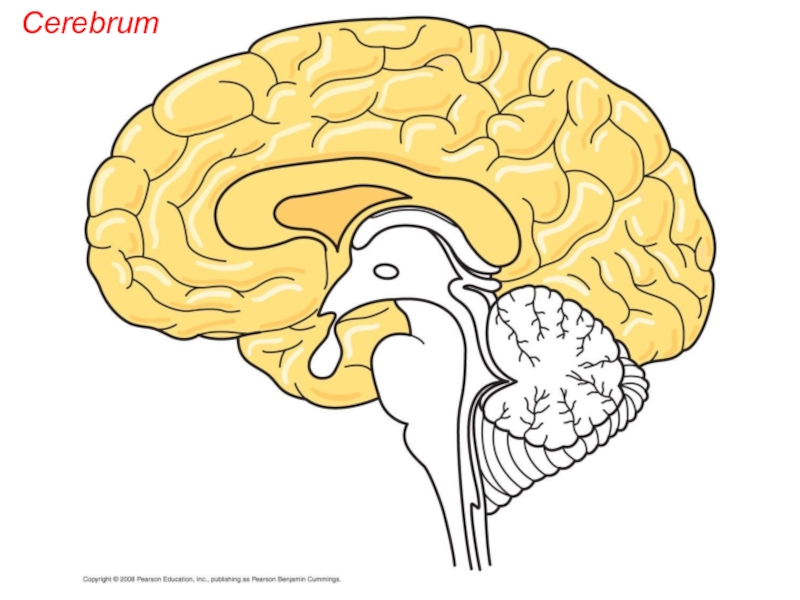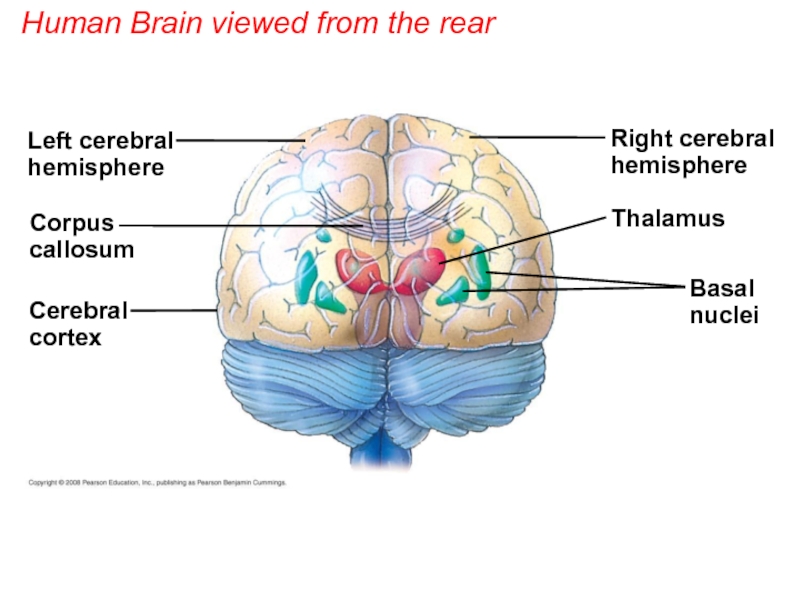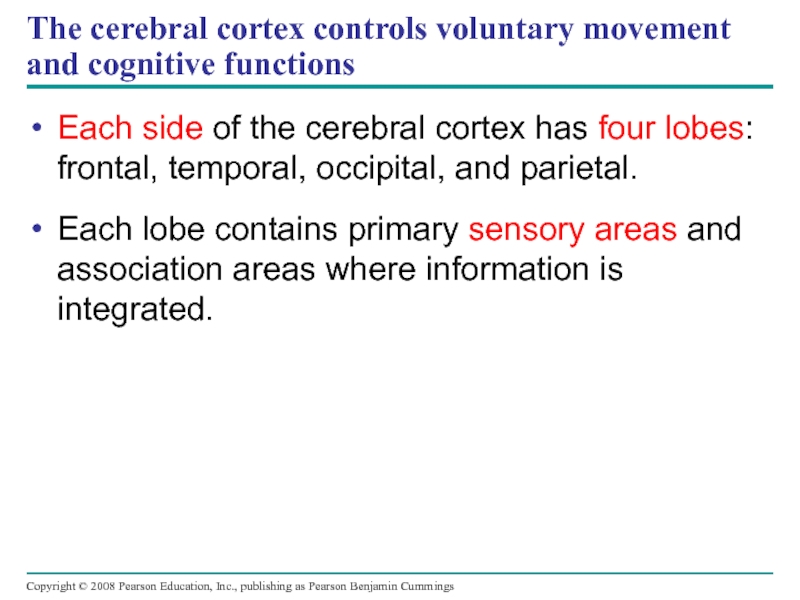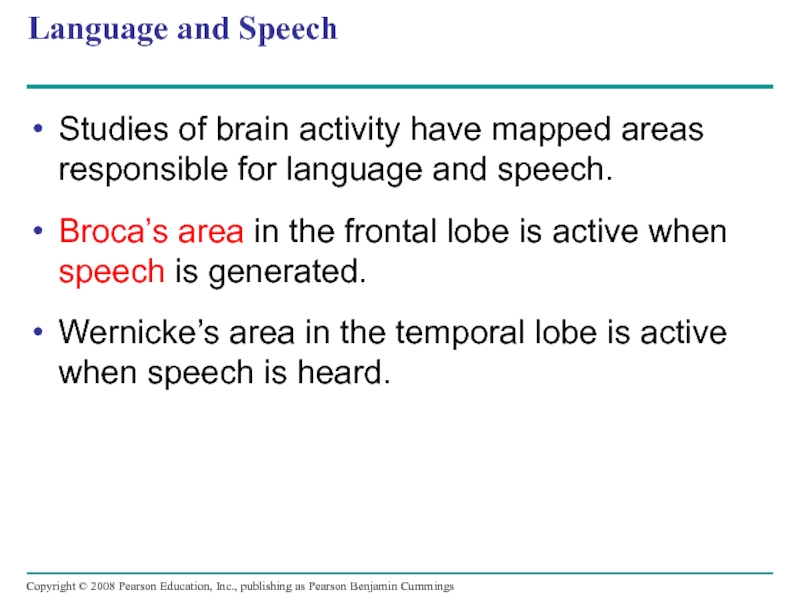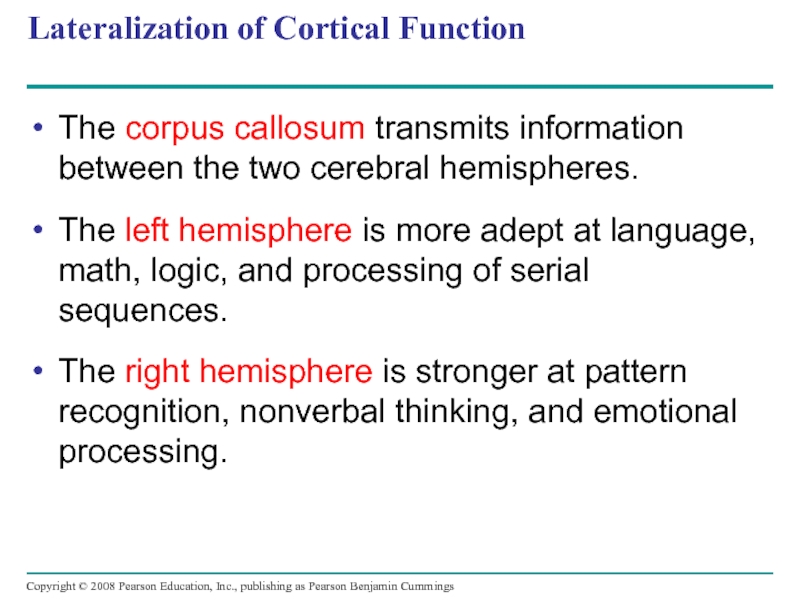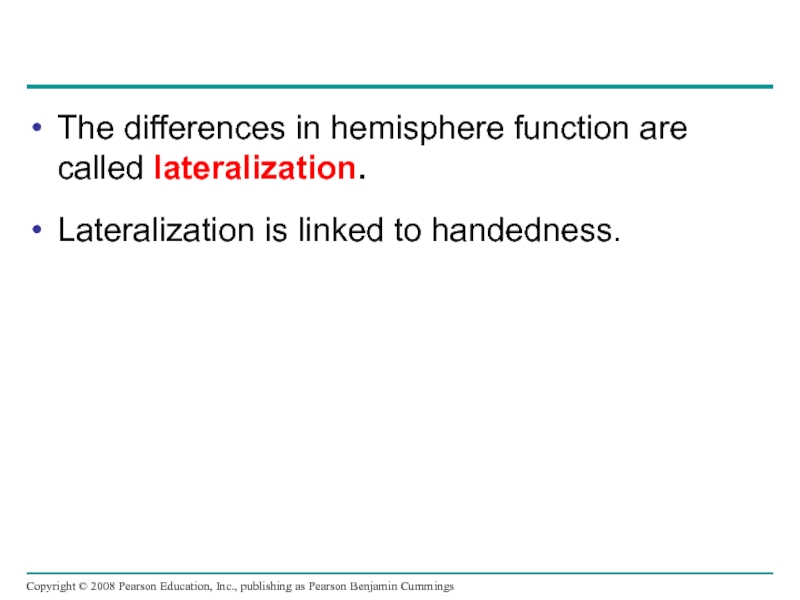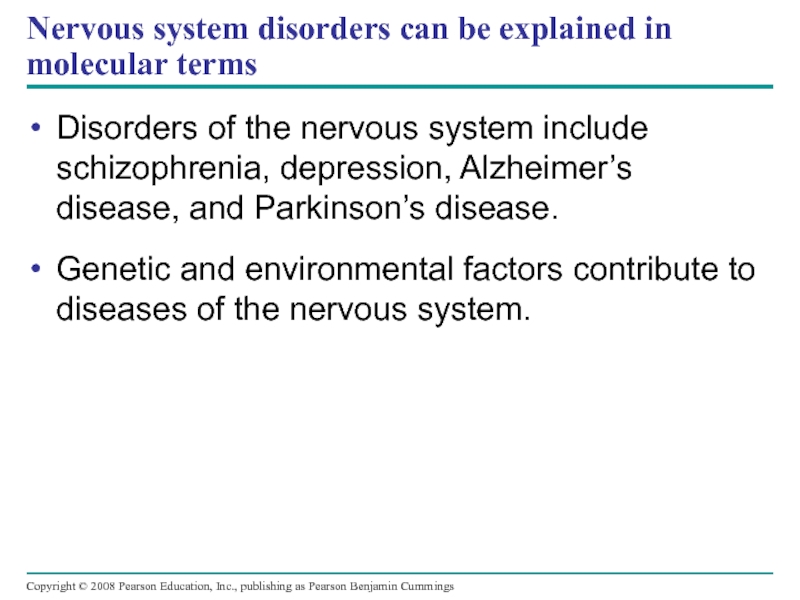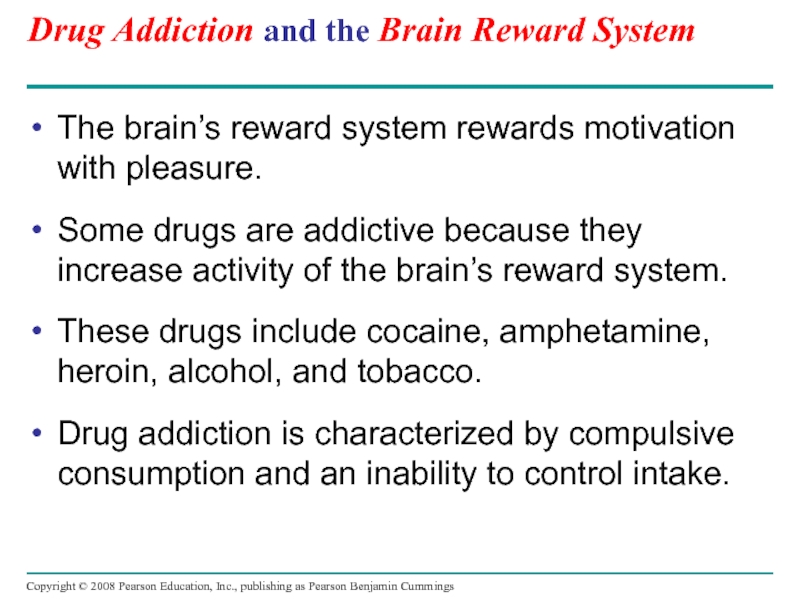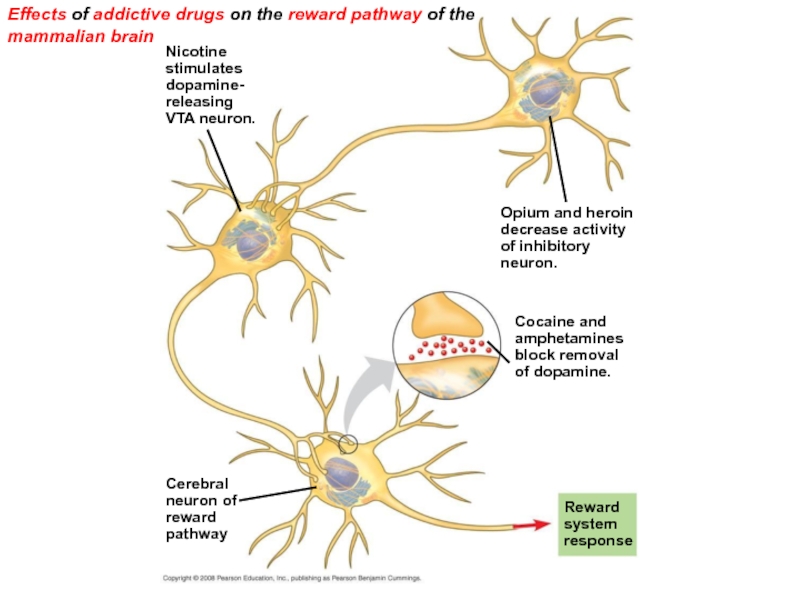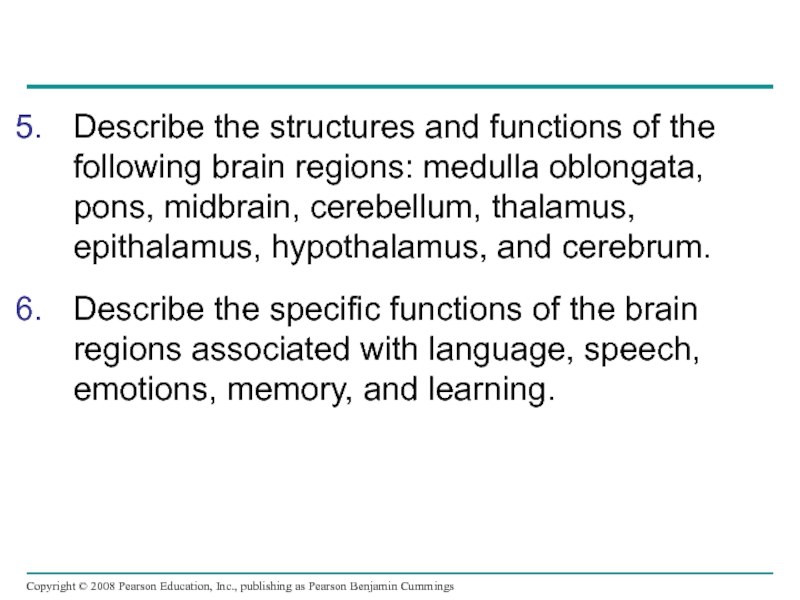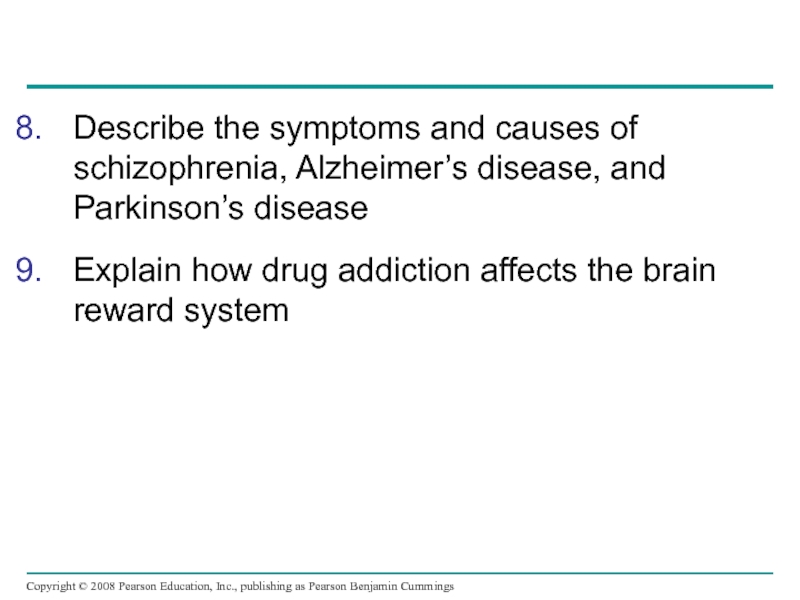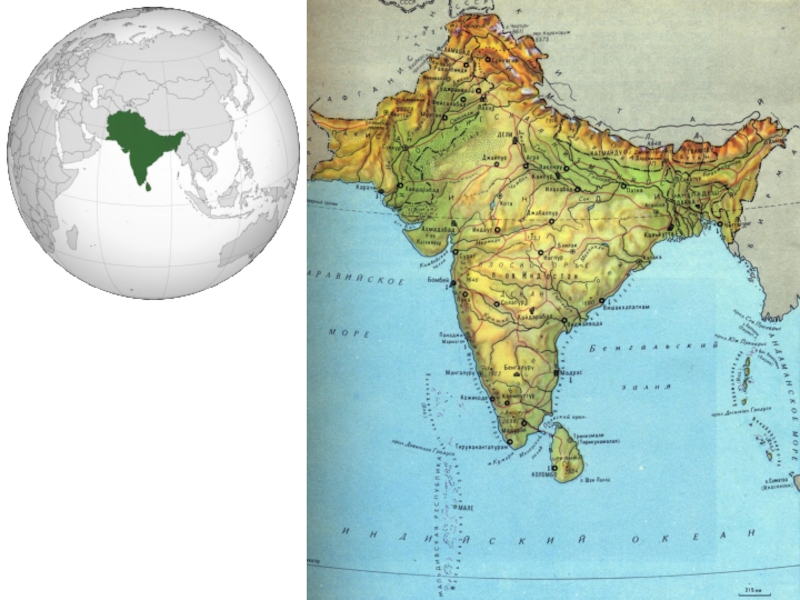Слайд 2Overview: Command and Control Center
The circuits in the brain are
more complex than the most powerful computers.
Functional magnetic resonance imaging
(MRI) can be used to construct a 3-D map of brain activity.
The vertebrate brain is organized into regions with different functions.
Слайд 3Scientists map activity within the human brain
Слайд 4Nervous systems consist of circuits of neurons and supporting cells
The
simplest animals with nervous systems, the cnidarians, have neurons arranged
in nerve nets.
A nerve net is a series of interconnected nerve cells. There is no central pathway / or directional organization.
More complex animals have nerves.
Слайд 5Nerves are bundles that consist of the axons of multiple
nerve cells.
Sea stars have a nerve net in each arm
connected by radial nerves to a central nerve ring.
Слайд 6Nervous system organization
(e) Insect (arthropod)
Segmental
ganglia
Ventral
nerve cord
Brain
(a) Hydra (cnidarian)
Nerve net
Nerve
ring
Radial
nerve
(b) Sea
star (echinoderm)
Anterior
nerve ring
Longitudinal
nerve cords
(f) Chiton (mollusc)
(g) Squid (mollusc)
Ganglia
Brain
Ganglia
(c) Planarian (flatworm)
Nerve
cords
Transverse
nerve
Brain
Eyespot
Brain
(d)
Leech (annelid)
Segmental
ganglia
Ventral
nerve
cord
Brain
Spinal
cord
(dorsal
nerve
cord)
Sensory
ganglia
(h) Salamander (vertebrate)
Слайд 7Hydra (cnidarian)
Nerve net
Nerve
ring
Radial
nerve
Sea star (echinoderm)
Слайд 8Bilaterally symmetrical animals exhibit cephalization.
Cephalization is the clustering of
sensory organs at the front end of the body.
Relatively simple
cephalized animals, such as flatworms, have a central nervous system (CNS).
The CNS consists of a brain and longitudinal nerve cords.
Слайд 9Planarian (flatworm)
Nerve
cords
Transverse
nerve
Brain
Eyespot
Brain
Leech (annelid)
Segmental
ganglia
Ventral
nerve
cord
Слайд 10Insect (arthropod)
Segmental
ganglia
Ventral
nerve cord
Brain
Anterior
nerve ring
Longitudinal
nerve cords
Chiton (mollusc)
Ganglia
Слайд 11
Annelids and arthropods have segmentally arranged clusters of neurons called
ganglia.
Nervous system organization usually correlates with lifestyle.
Sessile molluscs (e.g., clams
and chitons) have simple systems, whereas more complex molluscs (e.g., octopuses and squids) have more sophisticated systems.
Слайд 12Squid (mollusc)
Ganglia
Brain
Brain
Spinal
Cord
dorsal
nerve
cord
Sensory
ganglia
Salamander (vertebrate)
Слайд 13In vertebrates
The CNS is composed of the brain and spinal
cord.
The peripheral nervous system (PNS) is composed of nerves and
ganglia.
Слайд 14Organization of the Vertebrate Nervous System
The spinal cord conveys information
from the brain to the PNS.
The spinal cord also produces
reflexes independently of the brain.
A reflex is the body’s automatic response to a stimulus.
For example, a doctor uses a mallet to trigger a knee-jerk reflex.
Слайд 15knee-jerk Reflex
White
matter
Cell body of
sensory neuron in
dorsal root
ganglion
Spinal cord
(cross section)
Gray
matter
Hamstring
muscle
Quadriceps
muscle
Sensory neuron
Motor
neuron
Interneuron
Слайд 16Invertebrates usually have a ventral nerve cord while vertebrates have
a dorsal spinal cord.
The spinal cord and brain develop from
the embryonic nerve cord.
Слайд 17Vertebrate Nervous System
Peripheral nervous
system (PNS)
Cranial
nerves
Brain
Central nervous
system (CNS)
Ganglia
outside
CNS
Spinal
nerves
Spinal cord
Слайд 18Ventricles, gray matter, and white matter
White
matter
Ventricles
Gray matter
Слайд 19The central canal of the spinal cord and the ventricles
of the brain are hollow and filled with cerebrospinal fluid.
The
cerebrospinal fluid is filtered from blood and functions to cushion the brain and spinal cord.
Слайд 20The brain and spinal cord contain
Gray matter, which consists
of neuron cell bodies, dendrites, and unmyelinated axons.
White matter,
which consists of bundles of myelinated axons.
Слайд 21Glia in the CNS
Glia have numerous functions
Ependymal cells promote circulation
of cerebrospinal fluid.
Microglia protect the nervous system from microorganisms.
Oligodendrocytes and
Schwann cells form the myelin sheaths around axons.
Слайд 22Glia have numerous functions
Astrocytes provide structural support for neurons, regulate
extracellular ions and neurotransmitters, and induce the formation of a
blood-brain barrier that regulates the chemical environment of the CNS
Radial glia play a role in the embryonic development of the nervous system.
Слайд 23Glia in the vertebrate nervous system
Oligodendrocyte
Microglial
cell
Schwann cells
Ependy-
mal
cell
Neuron
Astrocyte
CNS
PNS
Capillary
(a) Glia in vertebrates
(b)
Astrocytes (LM)
VENTRICLE
50 µm
Слайд 24The Peripheral Nervous System
The PNS transmits information to and from
the CNS and regulates movement and the internal environment.
In the
PNS, afferent neurons transmit information to the CNS and efferent neurons transmit information away from the CNS.
Cranial nerves originate in the brain and mostly terminate in organs of the head and upper body.
Spinal nerves originate in the spinal cord and extend to parts of the body below the head.
Слайд 25peripheral nervous system
Efferent
neurons
Locomotion
Motor
system
Autonomic
nervous system
Afferent
(sensory) neurons
PNS
Hearing
Circulation
Gas exchange
Digestion
Hormone
action
Enteric
division
Sympathetic
division
Parasympathetic
division
Слайд 26The PNS has two functional components: the motor system and
the autonomic nervous system.
The motor system carries signals to skeletal
muscles and is voluntary.
The autonomic nervous system regulates the internal environment in an involuntary manner.
Слайд 27The PNS autonomic nervous system has sympathetic, parasympathetic, and enteric
divisions
The sympathetic and parasympathetic divisions have antagonistic effects on target
organs.
Слайд 28The sympathetic division correlates with the “fight-or-flight” response.
The parasympathetic division
promotes a return to “rest and digest.”
The enteric division controls
activity of the digestive tract, pancreas, and gallbladder.
Слайд 29PNS:
autonomic nervous system
Stimulates glucose
release from liver;
inhibits gallbladder
Dilates pupil
of eye
Parasympathetic division
Sympathetic
division
Action on target organs:
Inhibits salivary
gland secretion
Accelerates heart
Relaxes bronchi
in lungs
Inhibits
activity
of stomach and
intestines
Inhibits activity
of pancreas
Stimulates
adrenal medulla
Inhibits emptying
of bladder
Promotes ejaculation and
vaginal contractions
Constricts pupil
of eye
Stimulates salivary
gland secretion
Constricts
bronchi in lungs
Slows heart
Stimulates activity
of stomach and
intestines
Stimulates activity
of pancreas
Stimulates
gallbladder
Promotes emptying
of bladder
Promotes erection
of genitals
Action on target organs:
Cervical
Sympathetic
ganglia
Thoracic
Lumbar
Synapse
Sacral
Слайд 31The vertebrate brain is regionally specialized
All vertebrate brains develop from
three embryonic regions: forebrain, midbrain, and hindbrain.
By the fifth week
of human embryonic development, five brain regions have formed from the three embryonic regions.
Слайд 32Development of the human brain
Pons (part of brainstem), cerebellum
Forebrain
Midbrain
Hindbrain
Midbrain
Forebrain
Hindbrain
Telencephalon
Telencephalon
Diencephalon
Diencephalon
Mesencephalon
Mesencephalon
Metencephalon
Metencephalon
Myelencephalon
Myelencephalon
Spinal cord
Spinal
cord
Cerebrum (includes cerebral cortex, white matter,
basal nuclei)
Diencephalon (thalamus, hypothalamus, epithalamus)
Midbrain
(part of brainstem)
Medulla oblongata (part of brainstem)
Pituitary
gland
Cerebrum
Cerebellum
Central canal
Diencephalon:
Hypothalamus
Thalamus
Pineal gland
(part of epithalamus)
Brainstem:
Midbrain
Pons
Medulla
oblongata
(c) Adult
(b) Embryo at 5 weeks
(a) Embryo at 1 month
Слайд 33As a human brain develops further, the most profound change
occurs in the forebrain, which gives rise to the cerebrum.
The
outer portion of the cerebrum called the cerebral cortex surrounds much of the brain.
Слайд 35The Brainstem
The brainstem coordinates and conducts information between brain centers.
The
brainstem has three parts: the midbrain, the pons, and the
medulla oblongata.
Слайд 36The midbrain contains centers for receipt and integration of sensory
information.
The pons regulates breathing centers in the medulla.
The medulla oblongata
contains centers that control several functions including breathing, cardiovascular activity, swallowing, vomiting, and digestion.
Слайд 37Arousal and Sleep
The brainstem and cerebrum control arousal and sleep.
The
core of the brainstem has a diffuse network of neurons
called the reticular formation.
This regulates the amount and type of information that reaches the cerebral cortex and affects alertness.
The hormone melatonin is released by the pineal gland and plays a role in bird and mammal sleep cycles.
Слайд 38Reticular Formation
Input from touch,
pain, and temperature
receptors
Reticular formation
Eye
Input from nerves
of ears
Слайд 39Sleep is essential and may play a role in the
consolidation of learning and memory.
Dolphins sleep with one brain hemisphere
at a time and are therefore able to swim while “asleep.”
Слайд 40The Cerebellum
The cerebellum is important for coordination and error checking
during motor, perceptual, and cognitive functions.
It is also involved in
learning and remembering motor skills.
Слайд 42The Diencephalon
The diencephalon develops into three regions: the epithalamus, thalamus,
and hypothalamus.
The epithalamus includes the pineal gland and generates cerebrospinal
fluid from blood.
The thalamus is the main input center for sensory information to the cerebrum and the main output center for motor information leaving the cerebrum.
The hypothalamus regulates homeostasis and basic survival behaviors such as feeding, fighting, fleeing, and reproducing.
Слайд 44Biological Clock Regulation by the Hypothalamus
The hypothalamus also regulates circadian
rhythms such as the sleep/wake cycle.
Mammals usually have a pair
of suprachiasmatic nuclei (SCN) in the hypothalamus that function as a biological clock.
Biological clocks usually require external cues to remain synchronized with environmental cycles.
Слайд 46The cerebrum has right and left cerebral hemispheres.
Each cerebral hemisphere
consists of a cerebral cortex (gray matter) overlying white matter
and basal nuclei.
In humans, the cerebral cortex is the largest and most complex part of the brain.
The basal nuclei are important centers for planning and learning movement sequences.
Cerebrum
Слайд 47A thick band of axons called the corpus callosum provides
communication between the right and left cerebral cortices.
The right half
of the cerebral cortex controls the left side of the body, and vice versa.
Слайд 48Human Brain viewed from the rear
Corpus
callosum
Thalamus
Left cerebral
hemisphere
Right cerebral
hemisphere
Cerebral
cortex
Basal
nuclei
Слайд 49Evolution of Cognition in Vertebrates
The outermost layer of the cerebral
cortex has a different arrangement in birds and mammals.
In mammals,
the cerebral cortex has a convoluted surface called the neocortex, which was previously thought to be required for cognition.
Cognition is the perception and reasoning that form knowledge.
However, it has recently been shown that birds also demonstrate cognition even though they lack a neocortex.
Слайд 50The cerebral cortex controls voluntary movement and cognitive functions
Each side
of the cerebral cortex has four lobes: frontal, temporal, occipital,
and parietal.
Each lobe contains primary sensory areas and association areas where information is integrated.
Слайд 51human cerebral cortex
Speech
Occipital lobe
Vision
Temporal lobe
Frontal lobe
Parietal lobe
Somatosensory
association
area
Frontal
association
area
Visual
association
area
Reading
Taste
Hearing
Auditory
association
area
Speech
Smell
Motor cortex
Somatosensory cortex
Слайд 52Body part representation in primary motor and primary somatosensory cortices
Primary
somatosensory
cortex
Frontal lobe
Pharynx
Parietal lobe
Teeth
Gums
Jaw
Tongue
Lips
Face
Nose
Eye
Thumb
Fingers
Hand
Forearm
Elbow
Upper arm
Head
Neck
Trunk
Hip
Leg
Genitals
Abdominal
organs
Primary
motor cortex
Tongue
Toes
Jaw
Lips
Face
Eye
Brow
Neck
Fingers
Hand
Wrist
Forearm
Elbow
Shoulder
Trunk
Hip
Knee
Thumb
Слайд 53Language and Speech
Studies of brain activity have mapped areas responsible
for language and speech.
Broca’s area in the frontal lobe is
active when speech is generated.
Wernicke’s area in the temporal lobe is active when speech is heard.
Слайд 54Mapping language areas in the cerebral cortex
Generating
words
Max
Speaking
words
Hearing
words
Seeing
words
Min
Слайд 55Lateralization of Cortical Function
The corpus callosum transmits information between the
two cerebral hemispheres.
The left hemisphere is more adept at
language, math, logic, and processing of serial sequences.
The right hemisphere is stronger at pattern recognition, nonverbal thinking, and emotional processing.
Слайд 56The differences in hemisphere function are called lateralization.
Lateralization is linked
to handedness.
Слайд 57Emotions
Emotions are generated and experienced by the limbic system and
other parts of the brain including the sensory areas.
The limbic
system is a ring of structures around the brainstem that includes the amygdala, hippocampus, and parts of the thalamus.
The amygdala is located in the temporal lobe and helps store an emotional experience as an emotional memory.
Слайд 58The limbic system
Thalamus
Hypothalamus
Prefrontal
cortex
Olfactory
bulb
Amygdala
Hippocampus
Слайд 59Neural Plasticity
Neural plasticity describes the ability of the nervous system
to be modified after birth.
Changes can strengthen or weaken signaling
at a synapse.
Слайд 60Memory and Learning
Learning can occur when neurons make new connections
or when the strength of existing neural connections changes.
Short-term memory
is accessed via the hippocampus.
The hippocampus also plays a role in forming long-term memory, which is stored in the cerebral cortex.
Слайд 61Nervous system disorders can be explained in molecular terms
Disorders of
the nervous system include schizophrenia, depression, Alzheimer’s disease, and Parkinson’s
disease.
Genetic and environmental factors contribute to diseases of the nervous system.
Слайд 62Schizophrenia
About 1% of the world’s population suffers from schizophrenia.
Schizophrenia is
characterized by hallucinations, delusions, blunted emotions, and other symptoms.
Available treatments
focus on brain pathways that use dopamine as a neurotransmitter.
Слайд 63Depression
Two broad forms of depressive illness are known: major depressive
disorder and bipolar disorder.
In major depressive disorder, patients have a
persistent lack of interest or pleasure in most activities.
Bipolar disorder is characterized by manic (high-mood) and depressive (low-mood) phases.
Treatments for these types of depression include drugs such as Prozac and lithium.
Слайд 64Drug Addiction and the Brain Reward System
The brain’s reward system
rewards motivation with pleasure.
Some drugs are addictive because they increase
activity of the brain’s reward system.
These drugs include cocaine, amphetamine, heroin, alcohol, and tobacco.
Drug addiction is characterized by compulsive consumption and an inability to control intake.
Слайд 65Addictive drugs enhance the activity of the dopamine pathway.
Drug addiction
leads to long-lasting changes in the reward circuitry that cause
craving for the drug.
Слайд 66Effects of addictive drugs on the reward pathway of the
mammalian brain
Nicotine
stimulates
dopamine-
releasing
VTA neuron.
Cerebral
neuron of
reward pathway
Opium and heroin
decrease activity
of inhibitory
neuron.
Cocaine and
amphetamines
block
removal
of dopamine.
Reward
system
response
Слайд 67Alzheimer’s Disease
Alzheimer’s disease is a mental deterioration characterized by confusion,
memory loss, and other symptoms.
Alzheimer’s disease is caused by the
formation of neurofibrillary tangles and amyloid plaques in the brain.
A successful treatment in humans may hinge on early detection of amyloid plaques.
There is no cure for this disease though some drugs are effective at relieving symptoms.
Слайд 68Microscopic signs of Alzheimer’s disease
Amyloid plaque
20 µm
Neurofibrillary tangle
Слайд 69Stem Cell–Based Therapy
Unlike the PNS, the CNS cannot fully repair
itself.
However, it was recently discovered that the adult human brain
contains stem cells that can differentiate into mature neurons.
Induction of stem cell differentiation and transplantation of cultured stem cells are potential methods for replacing neurons lost to trauma or disease.
Слайд 70Human Brain
Cerebrum
Thalamus
Hypothalamus
Pituitary gland
Forebrain
Cerebral
cortex
Midbrain
Hindbrain
Pons
Medulla
oblongata
Cerebellum
Spinal
cord
Слайд 71You should now be able to:
Compare and contrast the nervous
systems of: hydra, sea star, planarian, nematode, clam, squid, and
vertebrate.
Distinguish between the following pairs of terms: central nervous system, peripheral nervous system; white matter, gray matter; bipolar disorder and major depression.
List the types of glia and their functions.
Compare the three divisions of the autonomic nervous system.
Слайд 72Describe the structures and functions of the following brain regions:
medulla oblongata, pons, midbrain, cerebellum, thalamus, epithalamus, hypothalamus, and cerebrum.
Describe
the specific functions of the brain regions associated with language, speech, emotions, memory, and learning.
Слайд 73Describe the symptoms and causes of schizophrenia, Alzheimer’s disease, and
Parkinson’s disease
Explain how drug addiction affects the brain reward system





